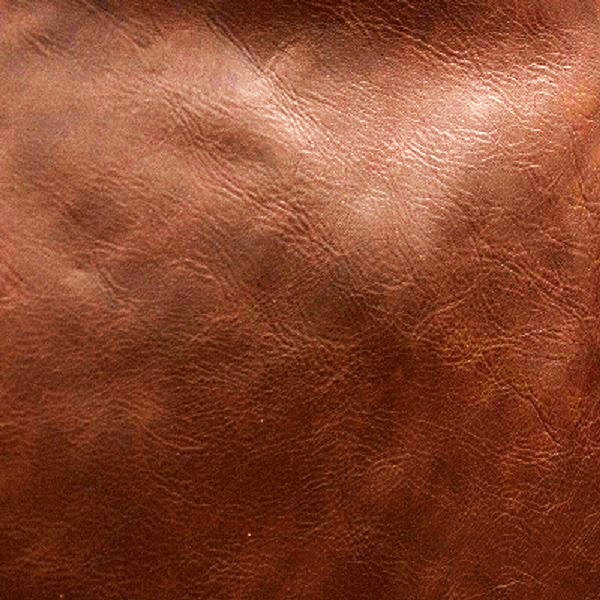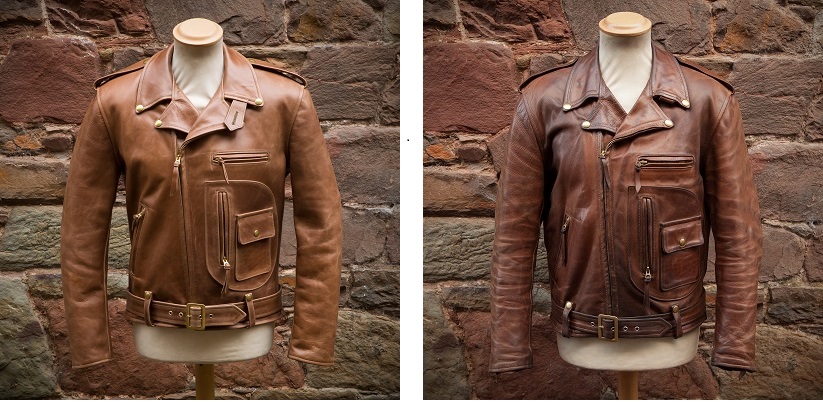
A leather's 'grain' refers to the natural pattern or texture of the animal hide from which the leather is made. The grain is the topmost layer of the hide and is formed by the arrangement of collagen fibres, which give leather its strength and durability. The grain pattern is unique to each individual animal and can vary depending on the species, breed, age, and environmental conditions of the animal.
However, when we refer to a jacket or leather as 'full grain', we aren't necessarily talking about the amount or level of grain within a jacket.
In this context, the term 'full grain' refers to the part of the hide (uppermost layer) that is included when making the leather and to the way it's processed prior to tanning.
What does 'full-grain' mean?
Full-grain leather (pictured above) is considered the highest quality leather available. It is made from the top layer of animal hide, which is the outermost layer that is closest to the hair. This part of the hide has the tightest grain and is the most durable, which makes it ideal for leather products that require strength and longevity.
Unlike other types of leather (such as top-grain and split leathers), full-grain leather is not sanded or buffed to remove any imperfections or blemishes. Instead, it is left in its natural state, which means that it retains all of its natural marks which are unique to that animal and add to the character and beauty of the leather.
Because all of the natural characteristics of the leather remain intact, including its natural oil-absorbing properties, the resulting leather is highly durable, develops a stunning and unique natural patina, and boasts a huge amount of character that other types of leather simply can't match.
Full-grain leather is used to create a wide range of products, including jackets, bags, wallets, shoes, and furniture. Because of its durability and natural beauty, it is often more expensive than other types of leather. However, the investment is worth it, as full-grain leather products are built to last and become more beautiful with age.
Because all of the natural characteristics of the leather remain intact, including its natural oil-absorbing properties, the resulting leather is highly durable, develops a stunning natural patina, and boasts a huge amount of character that other types of leather simply can't match.
Here you can see a leather jacket made of Natural Chromexcel Front Quarter Horsehide (one of the full-grain leathers that we offer). The first image, on the left, shows the jacket in its original state. The second image, on the right, shows the jacket after 2 or 3 years of wear. This gives you an idea of how the character of full-grain leather develops over time.

What is 'top-grain' leather?
Now that we've explained what full-grain leather is, let's talk about top-grain leather. Top-grain leather is the next grade down from full-grain leather, and that's because it's usually been sanded down to create a more uniform finish. Sanding away imperfections creates a leather that's a little bit easier to work with, but it doesn't have the same character that full-grain leather offers.
The exposed top surface of top-grain leather makes it a great candidate for the application of different finishes (be they stains, oils or pigments). This is useful if you need to produce a batch of leather products that all look alike, but it can compromise the overall durability of the leather, meaning garments made from top-grain leather might not last as long as those made from full-grain leather.
That being said, top-grain leather is still a good, workable leather that's used widely in the production of luxury goods, but not good enough for Aero where we exclusively use full grain leathers.
What is 'split' leather?
Split leather is a term used to describe leather that's made from the inner layer of the animal's skin (also known as the corium) once it's been removed from the grain layer. You might think that the inner layer of skin would be no good for making garments, but actually, a large percentage of the world's leather goods are made of split leather.
Manufacturers who are looking for a very pliable, versatile leather will often use the split layer because it can be processed much more easily than the upper layers we've already discussed. If you see leather that's been embossed with a very uniform texture or grain, it's likely to be split leather. We refer to this artificially-grained leather as 'corrected-grain leather'.
Another reason why manufacturers like to use split leather is because they can still advertise their products as being made with 'real' leather, even though the overall quality and durability of the leather is far less than that of top-grain or full-grain leathers. As you can imagine, the lower layers of the skin lack any real character, so the resulting leather products don't have the same beautifully natural qualities as products made with other grains.
What type of leather is best for me?
If you're looking for a high-quality leather product that is built to last and one that develops a rich patina and only looks better with age, then you simply must choose full-grain leather. While full-grain leather goods tend to me more expensive than split leather products and even top-grain leather products, you get what you pay for, and there is no substitute for the characteristics of full-grain leather – it truly is the 'real deal'.
Here at Aero Leather Clothing, we only work with the very best full-grain leathers from around the world. We've curated our collection over many years of sampling dozens of the most highly regarded leathers in the industry. Alongside the famed Chromexcel® from Horween, we have a wide range of stunning midweight Horsehides and Steerhides, and we continue to search for the very best full-grain leathers in the world to introduce to our customers and craft into our classic designs.
See Our Process to learn more about how our world-famous leather jackets are made, or click the link below to order an Aero jacket of your very own.
Aero Leather Jackets >
READ MORE: How Much Should a Quality Leather Jacket Cost?